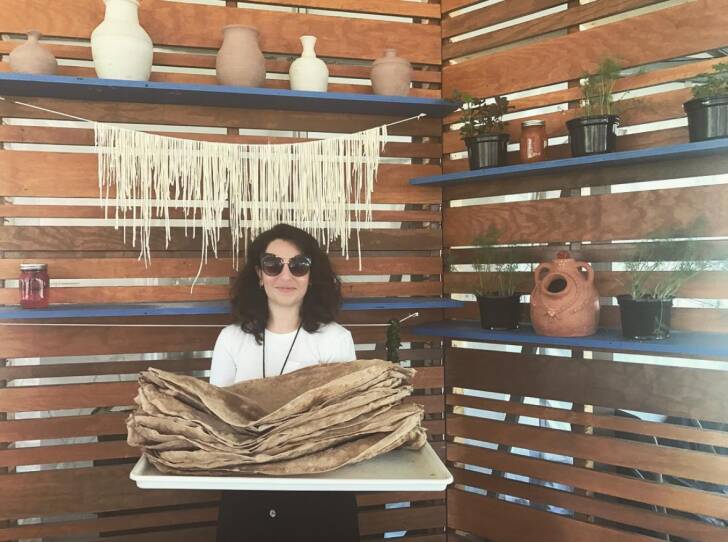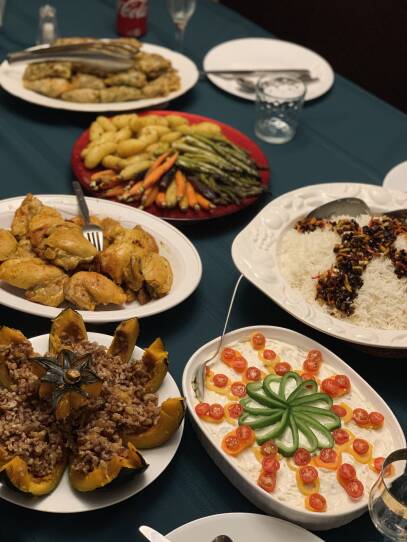This winter, my editor came to me with an observation she’d made at Sevan Bakery on Mount Auburn Street in Watertown. Among the börek and baklava and trays of briny feta, one particular item had caught her attention. Or rather, its price tag had: the white, inch-thick cream was for sale at $30 per pound.
She lobbed a few questions at the owner about the cream’s name, origins and why it was priced so luxuriously.
The answers: Kaymak; Turkish; production is very labor intensive.
Of course, one question begat another. Since Sevan is an Armenian shop, run by an Armenian family, and located in a major hub of the Armenian diaspora — what does it mean that a Turkish delicacy is made and sold here, especially given the longstanding tension between the two countries over the Armenian genocide of World War I?
“It’s a complicated question, and it kind of makes me squirm a little bit because food doesn’t really know country,” said journalist Liana Aghajanian, who has previously written about Armenian identity and cuisine.
“It doesn’t know politics. It doesn’t know borders. It’s hard to say, ‘I own this and you’re not allowed to have that,’ or vice versa, because there’s so many countries in that entire region that count that kind of food as part of their table. But we tend to use food and play with food as a political tool,” she said.
Kaymak well illustrates this point. It’s a simple food, similar to clotted cream. And while kaymak is traditionally made with water buffalo milk to produce its white color, rich flavor and velvety mouthfeel, Sevan’s Nuran Chavushian uses cow’s milk.
The ‘diasporic table’
The milk sits at a low simmer for several hours. Then, it’s set aside to cool as the cream rises to the top. Finally, it’s rolled up and packaged.
At Sevan, a normal batch yields about five to six pounds of kaymak, starting with four gallons of milk. But within three days, Chavushian said, it’s sold out.
Chavushian is a second-generation co-owner of the bakery and provisions market. His family is Armenian, and immigrated to Watertown from Istanbul in 1979. Five years later, his father bought the shop that would become the current incarnation of Sevan.
While kaymak may have origins within the borders of modern-day Turkey, the former Ottoman Empire ruled over dozens of ethnic groups before its fall in the 1920s, sprawling from edges of the Sahara to the Kingdom of Hungary.
And as a community — in this case Armenians — disperses, members bring their own food traditions with them. The diasporic table becomes an edible representation of shared history and pathways.
“That could not be more prominent in the Armenian case,” said Aghajanian. “We’re very spread out in different regions in the world, and in those areas that we’ve settled because of some traumatic history or immigration, we have contributed to and taken from those countries that we’ve been in.”

Food is no exception, Aghajanian said.
“The food on the table essentially acts as a kind of portal to other places, to tangible history, because Armenians come from places that they no longer exist in, that they’ve had to leave, that they’ve been forced to leave,” she said.
Given that history, it’s no surprise that an Armenian family with roots in Istanbul would incorporate that food into their in-house culinary tradition here in Watertown.
What’s in a name?
Conversely, Aghajanian — whose family came to the United States via Tehran, and who now lives in Los Angeles — will have an Armenian table that differs from most in Watertown. She’s familiar with kaymak, but her family refers to it by its Persian name: khameh.
And the delicacy has been carried across borders, said Sevan’s Chavusian.
“It’s also called qishta in the Arabic language,” said Chavusian. “So that whole region has their own little twist to it. The Croatians have it, but they have they add salt to theirs. [Theirs is] more like a meal where the kind we make is more of a dessert.”

Food and cookery are embodiments of cultural transmissions worldwide — just think of the bowls of jollof, jambalaya and dirty rice, all interrelated dishes found throughout the African diaspora. And many foods that originated outside of the modern United States have become staples here, like soy sauce, cassava, chia seeds, sushi, and fish and chips.
Kaymak has appeared in historical records across centuries, a fact that translator and Ottoman food historian Mary Işın finds fascinating.
“There’s so many gaps in the history of food, but the kaymak is quite well documented — you know, the sultans were eating it,” she said.
For example, Işın points to the writings of the 15th-century French traveler Bertrandon de la Broquiere. On the return journey from a 1433 pilgrimage to the Holy Land, Betrandon, en route to Constantinople, made a stop in Bursa.
“Some Turkish travelers beckoned him over and they were cooking a sheep over a fire roast spit roasting it,” Işın said. “They invited him for a meal, and there was at least one highlight that made a lasting impression: “As well as the roasted lamb, we also had some kaymak, or buffalo cream, and it was so good and sweet that I ate of it till I almost burst.’”
Everything in moderation. Which is fine: there’s enough to go around the table.









